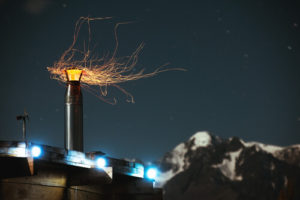Many homeowners are surprised by the findings of a chimney inspection. Without the eye and expertise of a trained and experienced professional, some issues may go unnoticed for months or years. Since a large part of the chimney system remains unseen, many homeowners won’t recognize a fire hazard!
Flue Fires Explained
A fire needs oxygen, fuel, and ignition in order to light and to burn. In a chimney, the sides of the flue become covered in soot and creosote which serves as a fuel. With adequate oxygen and ignition from the heat or sparks of the fire, the creosote can ignite fairly easily. However, you’d be surprised how little oxygen is available to the accidental chimney fire. Flue fires often burn out on their own due to lack of oxygen. You may have fire damage without ever knowing there was a fire!
Chimney Fire Damage
Many chimney fires happen quickly and burn out before a homeowner knows it happened. Creosote is made up mostly of tar, so it burns fast and feverishly. A flue fire of any size often results in broken and cracked flue liner and displaced, missing, or damaged mortar. Commonly, the first flue fire causes this type of unseen damage, then the next flue fire may utilize this damage to ignite other materials from the home, resulting in a catastrophic house fire.
Signs of a Fire
It can be difficult to recognize a flue fire, but it’s important to have it assessed and repaired.
There are two types of flue fires:
Free burning fires- Free burning fires are loud as a roaring train or airplane. They are a loud blaze that is obvious and flames or billowing smoke comes out the top of your chimney with dense smoke and a noticeable smell.
Slow burning fires- Slow burning fires often go undetected, burn slowly, and quieter. Signs are dense smoke from the chimney and a hot smell.
What to Do
If you detect a fire in your flue, you can smother it by cutting off the oxygen supply. Close the damper and vents that allow air into your fireplace or appliance. The lack of oxygen will smother the fire and allow you to have the damage assessed before lighting another fire. If you close the damper and your fire is burning in an open hearth, you must leave the house in order to avoid smoke inhalation. It is important to leave the house and call 911 to avoid loss of property or life. If you can do so safely, you can also spray water onto the roof around the chimney. Do not put yourself in harm’s way.
If your chimney has experienced a fire it’s important to call professionals to inspect the damage. A level 2 CSIA inspection will assess the entire chimney system, reporting on damage, big or small. This damage will have to be repaired before you use your fireplace again.
Spring is a great time to schedule your inspection and give yourself time for repairs before burn season. New Buck Chimney Services is happy to do a video inspection if you’re concerned about a fire.
Call New Buck today or make an appointment online.
